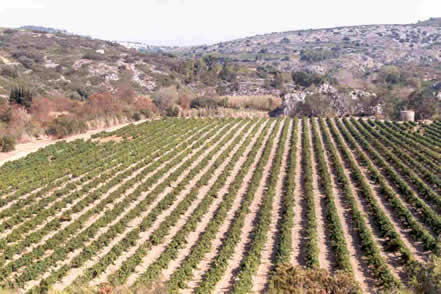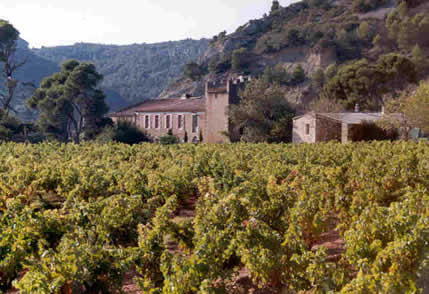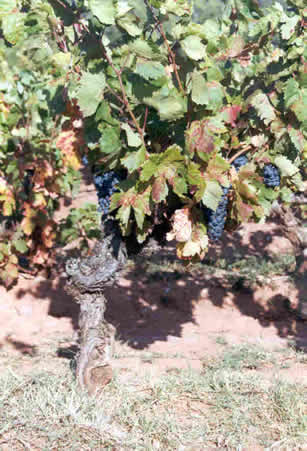|
Spotlight
on Corbières
 The
Corbières hills, in France’s Languedoc region, are breathtakingly
rugged, and quite beautiful. It’s a hot, dry region, and vines are
one of the few plants that do well in the nutrient-poor stony soils.
As an appellation, Corbières is the largest of the Languedoc, but you
get the impression that the high-end quality revolution that has hit
other parts of the Languedoc has passed it by a little: there aren’t
many superstar producers here. However, as this tasting showed, there
are quite a number of very good, satisfying wines being made, and the
situation is one of steady improvement of wine quality. The
Corbières hills, in France’s Languedoc region, are breathtakingly
rugged, and quite beautiful. It’s a hot, dry region, and vines are
one of the few plants that do well in the nutrient-poor stony soils.
As an appellation, Corbières is the largest of the Languedoc, but you
get the impression that the high-end quality revolution that has hit
other parts of the Languedoc has passed it by a little: there aren’t
many superstar producers here. However, as this tasting showed, there
are quite a number of very good, satisfying wines being made, and the
situation is one of steady improvement of wine quality.
It’s predominantly a red wine region (94% of all wines),
and the key grapes are Carignan, Cinsault, Grenache, Syrah and Mourvèdre.
Carignan has been commonly dismissed as being a second-tier grape, but
from low-yielding old vines it is capable of making extremely
satisfying wines with some southern spice, good structure and often a
slightly ‘stony’ aroma. Producers who are less careful with their
yields are still making fairly plonkish wines with it, though.
 The
region is split into 11 different ‘terroirs’, which are signposted
as you drive around. These are Montagne d’Alaric, Lagrasse, Lézignan,
Boutenac, Fontfroide, Sigean, Durban, Saint-Victor, Quéribus, Termenès
and Serviès. Because of the complex geology of the area, the soil
type can vary quite a bit from terroir to terroir. According to CIVL (Conseil
Interprofessional des Vins du Languedoc) the aim is to develop wine
trails and encourage wine tourism, focusing on the differences between
these terroirs -- a worthy goal. Indeed, as the general quality of the
wines here rises it would be interesting to try to characterise the
effects of these different soil types and climatic factors on the
taste of the wines. The
region is split into 11 different ‘terroirs’, which are signposted
as you drive around. These are Montagne d’Alaric, Lagrasse, Lézignan,
Boutenac, Fontfroide, Sigean, Durban, Saint-Victor, Quéribus, Termenès
and Serviès. Because of the complex geology of the area, the soil
type can vary quite a bit from terroir to terroir. According to CIVL (Conseil
Interprofessional des Vins du Languedoc) the aim is to develop wine
trails and encourage wine tourism, focusing on the differences between
these terroirs -- a worthy goal. Indeed, as the general quality of the
wines here rises it would be interesting to try to characterise the
effects of these different soil types and climatic factors on the
taste of the wines.

|
Corbières
factfile
|
|
15 000 hectares under production
|
|
2500 producers
|
|
49 caves cooperatives
|
|
411 independent cellars
|
|
Average yield 47 hl/ha
|
|
Source: CIVL
|
The wines tasted here were uniformly of a high standard, and
with the exception of the Tardieu super cuvées are all reasonably
priced. The Tardieu wines are unusual in that they are deliberately
fashioned in a very ambitious, showy style, with lots of everything.
The good news is, though, that they retain a sense of place. They may
upset purists but there’s certainly a place for them, and in this
style they are brilliantly put together.
Eliane ‘Gruissan’ 2000 Corbières
A single-vineyard selection made by Eliane Salinas, who in
addition to having her own domaine is also a flying winemaker (in
France and Chile). Quite deep coloured, this has a forward nose of
sweet ripe fruit with a liquoricey edge, minerally, stony richness and
a touch of smokiness. The palate is savoury and dense, with firm but
supple tannins and a minerally character. Satisfying stuff. Very good+
(around £6)
Château de Belle-Isle Vieilles Vignes 2000 Corbières
Deep purple/black colour. Savoury mineral nose is stony-edged and
leathery. The chunky, savoury palate displays a spicy edge to the
fruit. Restrained and quite structured this is quite satisfying. Very
good+ (Nicolas c. £7)
Domaine des Courtilles 1999 Corbières
Deep red/purple colour. Very sweet, liquoricey nose which is herby
and ripe. Quite seductive. The palate is quite rich but still nicely
balanced with sweet herby fruit and some oak influence. Not overblown.
Very good/excellent (£8.99 Waitrose)
Château Ollieux-Romanis 1999 Corbières
Unfiltered, unfined, unoaked. Quite a forward herby nose with some
sweet liquoricey berry fruit. Good concentration on the palate: this
is quite a ripe, forward style with nice, minerally, stony tannic edge
keeping things in balance. Quite savoury. Very good+ (Oddbins c. £7)
Tardieu Cuvée No 3 de Castelmaure 1999 Corbières
A blend of Syrah, Grenache and Carignan. Very deep purple/black
colour. Exotic, lush nose is almost overpowering with sweet herbal
liquoricey fruit. The palate is concentrated with rich, intense fruit,
spicy oak and some woody, tannic structure. A big wine in a full-on
style, but not unbalanced. Oaky though. Very good/excellent (£14.50
La Vigneronne)
Tardieu Cuvée No 3 de Castelmaure 1998 Corbières
Lovely rich, forward nose is noticeably smoky and spicy, with
sweet toffee-edged fruit underneath. Quite savoury on the palate with
a vanillin streak, some sweetness to the fruit and spicy tannins.
Showy, and I’d drink this soon. Very good+
Tardieu Château Roquefort St Martin 1999 Corbières
A blend of Mourvèdre, Grenache and Carignan. Red/black colour.
Slightly shy nose with a bit of spiciness. Dense, taut palate with
chunky fruit and firm tannins. Quite closed at the moment. Good
concentration of savoury fruit on the palate, but not giving much.
Very good+ (£13.95 La Vigneronne)
Tardieu Château Roquefort St Martin 1998 Corbières
Very deep purple/black colour. There’s a sweet herby edge to the
nose which displays a liquoricey edge. Concentrated, rich palate has
lots of rich fruit and some spicy oak, but it is not overdone. Quite
firm tannins and some attractive minerality. Good balance. Very
good/excellent
Château de Caraguilhes 1998 Corbières
Quite rich but focused herby smoky nose with a roasted edge and a
touch of sweet fruit. Intense and very savoury with plumy fruit on the
palate, a touch of spice and high acidity. Quite juicy and satisfying.
Very good+ (Waitrose c. £7)
Château Le Bouis 1988 Corbières
Sweet old wine nose is beguiling, with leathery, tea and cedar
notes. The palate has dried out a little but is still in balance,
thinning out but with some minerally tannins. Attractive stuff
drinking well now. Very good+
Wines
tasted at La
Vigneronne.
Back to top
|

 The
Corbières hills, in France’s Languedoc region, are breathtakingly
rugged, and quite beautiful. It’s a hot, dry region, and vines are
one of the few plants that do well in the nutrient-poor stony soils.
As an appellation, Corbières is the largest of the Languedoc, but you
get the impression that the high-end quality revolution that has hit
other parts of the Languedoc has passed it by a little: there aren’t
many superstar producers here. However, as this tasting showed, there
are quite a number of very good, satisfying wines being made, and the
situation is one of steady improvement of wine quality.
The
Corbières hills, in France’s Languedoc region, are breathtakingly
rugged, and quite beautiful. It’s a hot, dry region, and vines are
one of the few plants that do well in the nutrient-poor stony soils.
As an appellation, Corbières is the largest of the Languedoc, but you
get the impression that the high-end quality revolution that has hit
other parts of the Languedoc has passed it by a little: there aren’t
many superstar producers here. However, as this tasting showed, there
are quite a number of very good, satisfying wines being made, and the
situation is one of steady improvement of wine quality.  The
region is split into 11 different ‘terroirs’, which are signposted
as you drive around. These are Montagne d’Alaric, Lagrasse, Lézignan,
Boutenac, Fontfroide, Sigean, Durban, Saint-Victor, Quéribus, Termenès
and Serviès. Because of the complex geology of the area, the soil
type can vary quite a bit from terroir to terroir. According to CIVL (Conseil
Interprofessional des Vins du Languedoc) the aim is to develop wine
trails and encourage wine tourism, focusing on the differences between
these terroirs -- a worthy goal. Indeed, as the general quality of the
wines here rises it would be interesting to try to characterise the
effects of these different soil types and climatic factors on the
taste of the wines.
The
region is split into 11 different ‘terroirs’, which are signposted
as you drive around. These are Montagne d’Alaric, Lagrasse, Lézignan,
Boutenac, Fontfroide, Sigean, Durban, Saint-Victor, Quéribus, Termenès
and Serviès. Because of the complex geology of the area, the soil
type can vary quite a bit from terroir to terroir. According to CIVL (Conseil
Interprofessional des Vins du Languedoc) the aim is to develop wine
trails and encourage wine tourism, focusing on the differences between
these terroirs -- a worthy goal. Indeed, as the general quality of the
wines here rises it would be interesting to try to characterise the
effects of these different soil types and climatic factors on the
taste of the wines. 